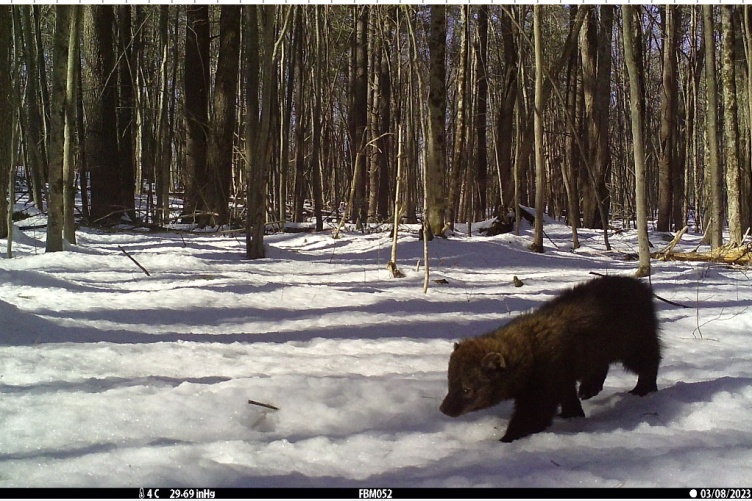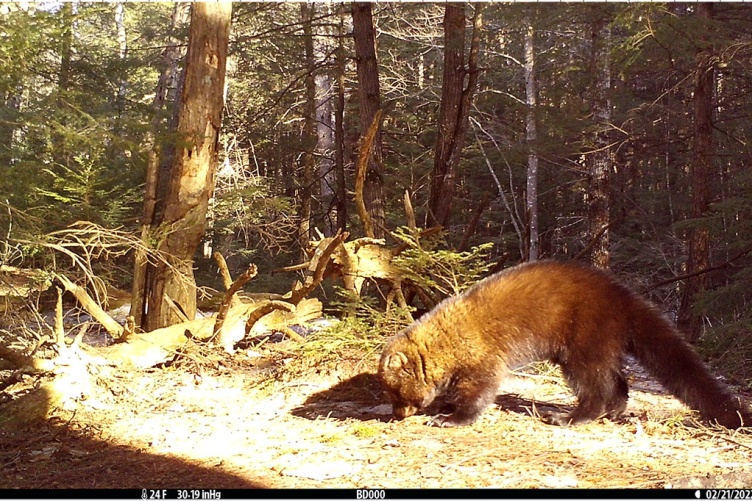A member of the weasel family, the fisher (Pekania pennanti) lives only in North America and is highly valued for its fur. A combination of habitat loss and over trapping led to the near extinction of the fisher (sometimes referred to as a fisher cat) in the early 1900s. And while trapping limits (two per season in the Granite State) and reintroduction programs have helped bolster their numbers since then, fisher populations in New Hampshire and throughout the Northeast have steadily declined over the past two decades. Now, thanks to a $1.2 million grant from the U.S. Fish and Wildlife Service and the N.H. Fish and Game Department, researchers from UNH’s College of Life Sciences and Agriculture will study what’s causing fishers in Northern New England to die out, and ultimately better understand the health of the Granite state’s fisher population.
Rem Moll, an assistant professor of natural resources and the environment, is co-leading the study, which he says will be unique to Northern New England and complement recent efforts in New York and Connecticut. An additional novel component to this study is the collaboration with David Needle, an associate clinical professor of molecular cellular, and biomedical sciences and veterinary pathologist at the New Hampshire Veterinary Diagnostic Lab (NHVDL), in assessing and determining fisher mortalities.
“Twenty years ago, fisher trapping success rate was high, but it’s declined since then and leveled out,” explained Moll. “And there are a lot of questions about why, so this new study will focus on survival and mortality rates and try to answer what fishers in Northern New England are dying from.”
Factors Affecting Fisher Populations
In addition to potential trapping effects, several theories exist for why fisher populations have been in decline, like the rise of the state’s bobcat populations as bobcats will target and kill female fishers where their territories overlap, adds Moll. Another troubling finding has been the presence of rodenticides in New England fishers tested at the NHVDL.
“Recent testing in our lab has found a high level of rodenticides, a specific pesticide used to control rodents, as well as canine distemper virus, in New England fishers and we’ll be looking for data on that as well as other diseases, using histopathology, PCR, next generation sequencing, and other tests to look for any trends in individual and population health,” said David Needle, pathology section chief at NHVDL and clinical associate professor at COLSA.
Researchers say there a number of factors that could be causing rodenticide poisoning in fishers. Wildlife cameras show that fisher populations appear to coexist with humans near developed areas in southeastern NH. That increases the possibility that rodenticides could play a role in fisher mortality because of its common use, especially when closing up summer homes for the winter season. Rodents who are exposed to the pesticide can be prey for the fishers and may in turn cause them harm as well.
Conservation Implications
Moll adds that fisher serve as an indicator species for the health of our Northeast forests, and issues found among the fishers may be indicative of broader problems.
“Fishers are an important part of the forest ecosystem and tell us a lot about the dynamics of the carnivore community,” he said. “They help control rodent populations and are also one of the few predators that can successfully hunt porcupines, and that might have benefits for forest health by minimizing bark and tree damage caused by porcupines.”
Along with using wildlife cameras set up in forests around the state, the researchers for this study will track the fisher population by outfitting them with GPS collars to better track and monitor survival and field mortalities. The collars will also include transmitters with mortality sensors for field recovery. Needle will then analyze pathology results, and a suite of molecular testing to look for toxins, blood-borne pathogens, bacteria, viruses, parasites, and other data that could identify disease in tissue.
“By determining the causes of mortality, we can add to the set of tools for assessing the region's fisher population,” Moll added. “Ultimately, we want to provide the best possible science so that these fishers can be managed and conserved effectively.”
-
Written By:
Robbin Ray ’82 | UNH Marketing | robbin.ray@unh.edu | 603-862-4864





















































